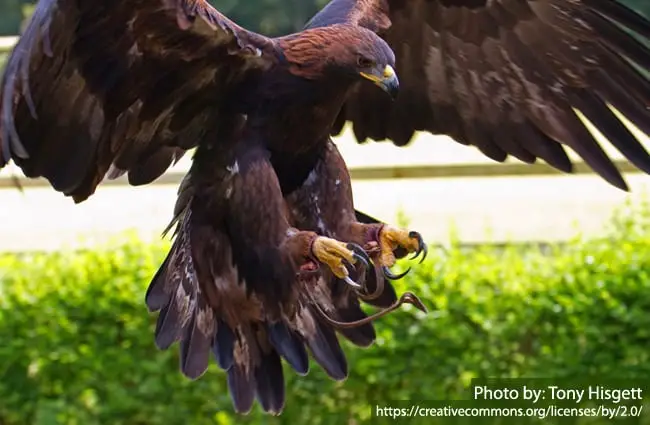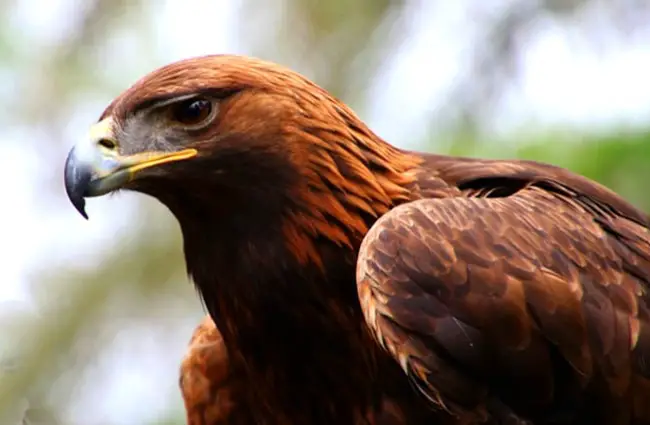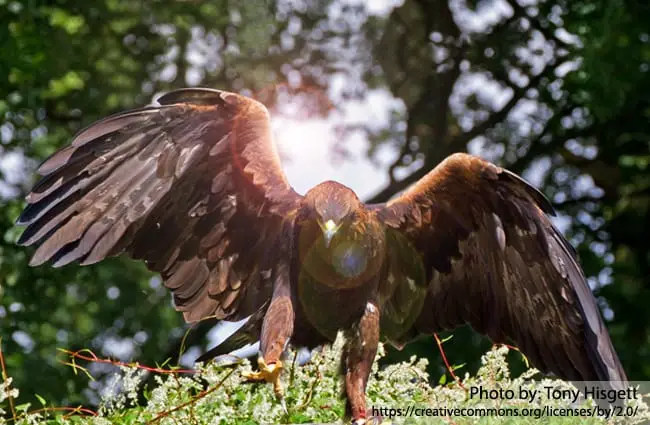The Golden Eagle: A Majestic Hunter of the Skies
Few sights in the natural world command as much awe and respect as the soaring silhouette of a Golden Eagle. This magnificent raptor, a symbol of power and freedom across countless cultures, truly embodies the wild spirit of the untamed landscapes it inhabits. From its piercing gaze to its formidable talons, every aspect of the Golden Eagle speaks to a creature perfectly adapted to its role as an apex predator. Delving into the life of this avian marvel reveals a complex tapestry of survival, intelligence, and ecological significance.

Spotting the Golden Monarch: Where and How to Find Them
For the aspiring wildlife enthusiast or the seasoned birdwatcher, encountering a Golden Eagle in its natural habitat is an unforgettable experience. These impressive birds boast one of the largest ranges of any raptor, gracing the skies of the Northern Hemisphere across North America, Eurasia, and parts of North Africa. They are typically found in open, mountainous, or hilly country, often interspersed with forests, scrubland, or grasslands. Look for them in:
- Western North America: Particularly abundant in the Rocky Mountains, Sierra Nevada, and across the vast plains and deserts.
- Eurasia: From the Scottish Highlands and Scandinavian mountains to the steppes of Central Asia and the Himalayas.
- North Africa: Present in mountainous regions.
To spot a Golden Eagle, patience and keen observation are key. Scan open landscapes with binoculars or a spotting scope. Look for large, dark birds soaring on broad, slightly dihedral (V-shaped) wings. Juveniles often display striking white patches at the base of their primary flight feathers and a white tail with a dark terminal band, making them easier to identify. Adults are uniformly dark brown with a golden wash on the nape and hindneck, which gives them their common name.

Encountering a Golden Eagle in the Wild: A Hiker’s Guide
Should you be fortunate enough to cross paths with a Golden Eagle during a hike, remember that respect and minimal disturbance are paramount. These are wild animals, and while generally not aggressive towards humans, they deserve their space.
- Maintain Distance: Observe from a respectful distance. Do not approach a nesting site or a bird that appears to be hunting or feeding.
- Stay Calm and Quiet: Sudden movements or loud noises can startle wildlife.
- Never Feed Wildlife: This can habituate animals to humans and disrupt their natural hunting behaviors.
- Enjoy the Spectacle: Take the opportunity to witness one of nature’s most powerful predators in action. Their flight is truly magnificent.

A Deeper Dive into the Golden Eagle’s World
Habitat and Range: Masters of Diverse Landscapes
The Golden Eagle, scientifically known as Aquila chrysaetos, is remarkably adaptable, thriving in a wide array of habitats. Their preferred territories typically combine open hunting grounds with elevated nesting sites. This includes:
- Mountainous Regions: Steep cliffs and rocky outcrops provide ideal nesting ledges and thermal updrafts for soaring.
- Open Country: Grasslands, prairies, tundra, and semi-deserts offer ample hunting opportunities for ground-dwelling prey.
- Forest Edges: While not deep forest dwellers, they utilize forest margins for perching and hunting.
- Coastal Areas: In some regions, they can be found along coastlines, preying on seabirds and marine mammals.
Their vast circumpolar distribution highlights their ecological flexibility, allowing them to exploit resources across varied climates, from arctic tundra to arid scrublands. This broad range also means they interact with a diverse array of other species, playing a crucial role in many ecosystems.

Evolutionary Journey: A Lineage of Power
The Golden Eagle belongs to the family Accipitridae, which includes most of the diurnal birds of prey such as hawks, kites, and Old World vultures. Its genus, Aquila, encompasses the “true eagles,” known for their large size, powerful build, and predatory prowess. The evolutionary history of these magnificent birds stretches back millions of years, with fossil records indicating the presence of eagle-like raptors in the Miocene epoch. Modern Golden Eagles are thought to have evolved from ancestors that adapted to hunting large ground prey in open environments, developing their characteristic strength, vision, and hunting techniques over millennia. Their widespread distribution suggests a successful evolutionary strategy, allowing them to colonize diverse environments and adapt to local prey availability.

Diet and Hunting Strategies: Apex Predator of the Air
As apex predators, Golden Eagles sit at the top of their food chain, influencing the populations of numerous prey species. Their diet is incredibly varied, reflecting their opportunistic nature and the diversity of their habitats. They are primarily carnivores, with a strong preference for medium-sized mammals and birds.
Primary Prey Includes:
- Mammals:
- Rabbits and hares (often a staple)
- Marmots, ground squirrels, and other rodents
- Foxes and young deer (fawns, sometimes even adult deer in winter)
- Badgers and other small carnivores
- Birds:
- Reptiles: Snakes and lizards in warmer climates.
- Carrion: Especially during lean times or winter, they will scavenge on carcasses.
Golden Eagles employ a variety of hunting techniques. They often soar high, using their exceptional eyesight to spot prey from great distances. Once a target is identified, they execute a spectacular stoop, diving at speeds that can exceed 150 miles per hour, striking with powerful talons. They also hunt from perches or by flying low over terrain to surprise prey. Their strength is legendary; they are capable of carrying prey weighing several pounds back to their nests.

Mating and Reproduction: A Lifelong Bond
Golden Eagles are monogamous, forming strong pair bonds that often last for life. Their breeding season typically begins in early spring, though it can vary by region.
The Mating and Reproduction Process:
- Courtship Displays: Pairs engage in elaborate aerial displays, including undulating flights, sky-dancing, and mock attacks, reinforcing their bond.
- Nest Building (Eyries): They construct massive nests, called eyries, on cliff ledges, in large trees, or on man-made structures like transmission towers. These nests are built from large sticks and branches, lined with softer materials like grass, moss, and fur. Eyries are often reused and expanded over many years, sometimes reaching enormous sizes.
- Egg Laying: Females typically lay 1 to 4 eggs, though 2 is most common. The eggs are dull white with brown or reddish blotches.
- Incubation: Both parents share incubation duties, which last for about 40 to 45 days. The female does the majority of the incubation.
- Hatching and Chick Rearing: Chicks hatch asynchronously, meaning they hatch at different times. The older, stronger chick often outcompetes its younger siblings for food, a phenomenon known as “cainism” or siblicide, which ensures the survival of the strongest offspring in times of scarcity.
- Fledging: Young eagles fledge, or take their first flight, at around 65 to 75 days old.
- Post-Fledging Care: Even after fledging, the young birds remain dependent on their parents for several weeks or even months, learning crucial hunting and survival skills.
The reproductive success of Golden Eagles is highly dependent on prey availability and the absence of human disturbance.

Ecosystem Contribution and Interactions with Other Animals
Golden Eagles are vital components of their ecosystems. As top predators, they play a critical role in regulating the populations of their prey species, preventing overgrazing or disease outbreaks that could destabilize the ecosystem. By preying on sick or weak individuals, they contribute to the overall health and vigor of prey populations.
Their interactions with other animals are primarily predatory, but they also compete with other large carnivores like wolves, coyotes, and even other large raptors for food resources. Scavenging on carrion means they also act as natural clean-up crews, preventing the spread of disease. Their presence is often an indicator of a healthy, robust ecosystem.
Golden Eagles and Human Culture: A Legacy of Reverence
Throughout history, the Golden Eagle has held a profound place in human culture, symbolizing strength, courage, freedom, and spiritual power. Its image appears in:
- Mythology and Religion: Revered by Native American tribes, often associated with the sun and divine power. In ancient Rome, it was the emblem of the legions.
- Heraldry: Adopted as a national emblem by numerous countries, including Germany, Austria, Mexico, and Kazakhstan.
- Falconry: For centuries, Golden Eagles have been trained for falconry, particularly in Central Asia, where they are used to hunt large prey like foxes and even wolves. This practice highlights the bird’s intelligence and trainability, forging a unique bond between human and raptor.
- Literature and Art: Frequently depicted in art and literature as a symbol of majesty and the wild.
This deep cultural connection underscores the bird’s enduring impact on the human psyche.

Interaction with Humans: Challenges and Conservation
Despite their revered status, Golden Eagles have faced significant challenges due to human activities. Historically, they were persecuted as perceived threats to livestock, leading to widespread hunting and poisoning campaigns. Today, major threats include:
- Habitat Loss and Fragmentation: Development, agriculture, and urbanization reduce their hunting grounds and nesting sites.
- Lead Poisoning: Ingestion of lead fragments from ammunition in carrion is a serious threat.
- Wind Turbines: Collisions with wind turbine blades are a growing concern in some areas.
- Electrocution: Collisions with power lines and electrocution on utility poles.
- Pesticides: Bioaccumulation of toxins in their prey.
Conservation efforts are crucial and include habitat protection, lead ammunition bans, retrofitting power lines, and public education. Their protected status in many countries reflects a growing understanding of their ecological importance and the need for their preservation.

Caring for Golden Eagles in Captivity: A Zookeeper’s Perspective
Caring for a Golden Eagle in a zoological setting is a demanding but rewarding endeavor, requiring specialized knowledge and dedication. Zookeepers play a vital role in the welfare, education, and conservation of these magnificent birds.
Key Tasks and Considerations for Zookeepers:
- Enclosure Design and Maintenance:
- Spaciousness: Enclosures must be large enough to allow for flight and natural behaviors, ideally with high ceilings.
- Perching: Provide varied perches at different heights and textures to promote foot health and natural roosting.
- Substrate: Easy-to-clean, non-abrasive substrate.
- Shelter: Protection from extreme weather conditions.
- Security: Robust construction to prevent escape and protect from external threats.
- Diet and Nutrition:
- Prey-based Diet: Mimic their natural diet with whole prey items such as rats, mice, quail, chicks, and rabbits.
- Supplementation: Ensure a balanced diet with appropriate vitamin and mineral supplements, especially calcium.
- Feeding Schedule: Regular, consistent feeding, adjusting quantities based on the bird’s activity level, age, and health.
- Hydration: Constant access to fresh, clean water for drinking and bathing.
- Health Monitoring and Veterinary Care:
- Daily Checks: Observe appetite, activity level, posture, feather condition, and droppings for any signs of illness or injury.
- Regular Vet Exams: Scheduled check-ups, including weight monitoring, blood tests, and parasite screening.
- Wing and Talon Care: Regular coping (trimming) of talons and beak if necessary, performed by experienced professionals.
- Enrichment:
- Behavioral Enrichment: Provide items that encourage natural behaviors like tearing, manipulating, and exploring. This can include puzzle feeders, varied perches, and novel objects.
- Environmental Enrichment: Changing the enclosure layout, adding natural elements like branches or rocks.
- Social Enrichment: If appropriate, housing with a compatible mate or other eagles (under expert guidance).
- Training and Handling:
- Positive Reinforcement: Training for husbandry behaviors (e.g., stepping onto a scale, presenting a foot) using positive reinforcement.
- Minimizing Stress: Handling should be minimized and performed calmly and efficiently by trained personnel.
- Record Keeping: Meticulous records of diet, weight, medical treatments, and behavioral observations.
What to Avoid in Captive Care:
- Inadequate Space: Small enclosures lead to stress, feather damage, and muscle atrophy.
- Improper Diet: Feeding processed foods or an unbalanced diet can lead to nutritional deficiencies and health problems.
- Lack of Enrichment: Can result in boredom, stereotypical behaviors, and poor welfare.
- Excessive Handling: Causes stress and can lead to fear or aggression.
- Poor Hygiene: Unclean enclosures can lead to bacterial or fungal infections.
- Isolation: While generally solitary, prolonged lack of appropriate stimulation can be detrimental.
Fascinating Facts About Golden Eagles
The Golden Eagle is a creature of endless wonder. Here is a huge list of interesting facts that highlight its unique adaptations and behaviors:
- Exceptional Eyesight: Golden Eagles possess vision 4 to 8 times sharper than that of humans, allowing them to spot a rabbit from two miles away.
- Impressive Wingspan: Their wingspan can reach up to 7.5 feet (2.3 meters), enabling powerful and efficient flight.
- Powerful Talons: Their talons are incredibly strong, capable of exerting over 750 pounds per square inch of pressure, strong enough to crush the bones of their prey.
- Long Lifespan: In the wild, Golden Eagles can live for 20 to 30 years, and even longer in captivity, sometimes exceeding 40 years.
- Speed Demons: While hunting, they can dive at speeds of up to 150-200 mph (240-320 km/h), making them one of the fastest animals on Earth.
- Massive Nests: Their eyries can be enormous, sometimes weighing over a ton and measuring up to 10 feet (3 meters) deep and 6 feet (1.8 meters) wide after years of additions.
- Silent Hunters: Despite their size, their flight is remarkably silent due to specialized feather structures that reduce turbulence.
- “Golden” Nape: The distinctive golden-brown feathers on their nape and hindneck are the source of their common name.
- Sibling Rivalry: The phenomenon of siblicide, where the older, stronger chick kills its younger siblings, is common, especially when food is scarce.
- Global Distribution: They are one of the most widely distributed raptors in the world, found across North America, Europe, Asia, and parts of Africa.
- Symbol of Nations: The Golden Eagle is the national bird of several countries, including Mexico, Albania, Germany, and Kazakhstan.
- Opportunistic Scavengers: While primarily hunters, they are not above scavenging carrion, especially during harsh winters.
- Territorial Defenders: Golden Eagles are fiercely territorial, defending their nesting and hunting grounds from intruders, including other eagles.
- Molt Pattern: They undergo a gradual molt, replacing feathers over several years to ensure they always have enough flight feathers for hunting.
- Sexual Dimorphism: Females are typically larger and heavier than males, a common trait among raptors.
The Enduring Legacy of the Golden Eagle
The Golden Eagle stands as a testament to the raw power and intricate beauty of the natural world. From its soaring flights over rugged mountains to its vital role in maintaining ecological balance, this magnificent raptor continues to inspire awe and respect. Understanding its biology, behavior, and cultural significance is not just an academic exercise; it is a call to action. Protecting the Golden Eagle and its habitats ensures that future generations will also have the privilege of witnessing this golden monarch rule the skies, a timeless symbol of wilderness and freedom.

![Red Angus Closeup of a beautiful Red Angus cowPhoto by: U.S. Department of Agriculture [pubic domain]https://creativecommons.org/licenses/by/2.0/](https://animals.net/wp-content/uploads/2020/03/Red-Angus-4-238x178.jpg)




![Red Angus Closeup of a beautiful Red Angus cowPhoto by: U.S. Department of Agriculture [pubic domain]https://creativecommons.org/licenses/by/2.0/](https://animals.net/wp-content/uploads/2020/03/Red-Angus-4-100x75.jpg)

